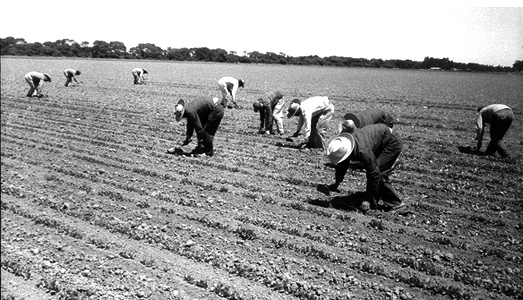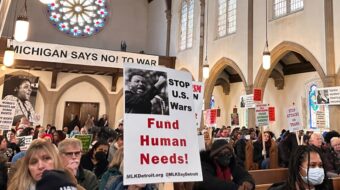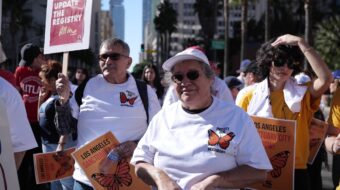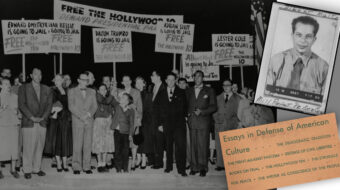
Now in theaters, Cesar Chavez, directed by Diego Luna and starring Michael Peña in the lead role, is a better expression of the filmmaking craft than an accurate depiction of history.
Though uneven, all is not wrong with a tale whose message is inspirational: excruciating suffering, great hurdles to overcome, momentary defeats, the long arc of justice, all activate our yearning to see the world made right. We need such films: If this one omits key points of fact, Americans of all “agendas” nevertheless need to see it.
Echoes reverberate to the present day, reminding us that the struggle continues under new conditions. In the main, are we not presently advocating a collective agenda for the whole country: affordable homes, good schools, a clean environment, healthy food, jobs at living wages, healthcare, security in our old age?
Accepting the principle of artistic license, we nevertheless might have expected more. Why did Luna shunt Larry Itliong and Phillip Vera Cruz, leaders of the Filipino farm workers, so far into the background? Why is Dolores Huerta’s character (played by Rosario Dawson) so poorly defined? Why is she little more than a device to assist in plot pivots? Chavez’s wife Helen (America Ferrera) leads the chant “Huelga!” (strike!) just after the court had deemed it forbidden speech. But other women were actually more involved in this early clash with growers as farm workers made their demands known.
Reference to the famous 1954 film “Salt of the Earth,” about Mexican-American miners in New Mexico, is inevitable. In both films the lead male appears as a male chauvinist who slowly grows out of his backward ways.
The UFW contended with local California sheriffs who acted no differently toward working people of color than the Bull Connors of the American South acted toward African-Americans and civil rights workers, a reminder of how closely the two movements tracked each other.
Giving Mr. Luna his due as a director, there are some exciting moments driven by hand-held cameras that rapidly move us along with and in the action as close-ups of key story elements appear onscreen. Such compelling visual immediacy engages our interest and attention.
Child of a farm worker family, Cesar was inspired to correct the terrible conditions his parents endured. He absorbed lessons from the CSO (Community Service Organization), and then began taking on the challenge of organizing farm workers in Central California.
[CSO is a grassroots organizing effort that empowered a generation of Mexican-Americans and changed the course of history for their children through voter registration drives, citizenship classes, lawsuits and legislative campaigns.] A quick study, he outmaneuvers his adversaries, steering his organization toward its best negotiating positions. Short handle hoes are abolished, farm worker union recognition is finally achieved, a modicum of dignity secured. The power of “Sí se puede” brought all of that, but in the end it would take some politician’s signature to make it stick.
Robert F. Kennedy and Chavez are shown as fellow travelers: Moments in the film touchingly recapitulate an iconic photograph of the two sitting side by side as RFK gently places a hand on the arm of the resolute labor leader weakened after almost a month-long fast.
We see newsreel clips of Governor Ronald Reagan, munching on boycotted grapes while accusing the farm workers of terroristic acts. Newly inaugurated President Nixon pontificates while horrific scenes of police riots in the California fields play out. Nixon ships grapes for sale in Europe, but the highly organized Europeans naturally would have none of it. A heartwarming scene is the “Boston Tea Party 2.0,” showing Chavez and his newfound British labor friends dumping grapes into the Thames River. To anyone reading these words-as we approach the last midterm elections of Obama’s presidency-It Matters Who We Elect!
Speaking of politicians, President Johnson, who was in office during much of the time covered in the film, goes unmentioned. Domestically, LBJ is now regarded as a great liberal, but of course there was Vietnam, which is only briefly touched on.
The famous trek from Delano to Sacramento was a “pilgrimage,” a rite of sacred deliverance directed at lawmakers. Pairing the movement with religion indemnified its participants from excessive criticism and harm.
As Chavez coyly asked, “How can Catholics be Communists?” In the potent anti-communist environment of the 1960s, he had to downplay his early associations with the Communist Party to gain union and public support.
Although never compromising ultimate principles such as nonviolence, Chavez skillfully rode the bucking bronco of history as each challenge came his way.
Go see the film. It’s flawed, but its heart is in the right place.
Photo: Farmworkers doing stooped labor with short-handled hoes in California. Bracero History Archive













Comments